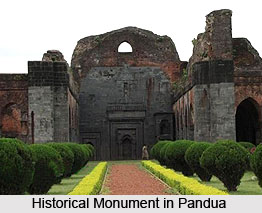 Pandua is a town situated in the Malda District, in the state of West Bengal at about 20 miles away from Gaur and twelve miles from Malda town. In the ancient past, 1342-1358 AD, during the period of Shamsuddin Iliyas Shah it was the capital of Bengal and had also emerged as mint town. Hindu myths claim that the name of the place has been derived from `Pandus` whereas Alexander Cunningham had contradictory beliefs that the place got its name from `Pandubis` or water fowls, which were found abundantly in Pandua. Before gaining the status of the capital in 1342, the place had already acquired substantial prominence owing to the presence of numerous Hindu sculptural and architectural remains. These also testify the town`s antiquity. The town was however small having a width of about two miles and length of half a mile. In 1353 the town was renamed as Firuzabad by Iliyas Shah in the honour of a former sultan of Bengal, Shamsuddin Firuz Shah (1301-1322 AD).
Pandua is a town situated in the Malda District, in the state of West Bengal at about 20 miles away from Gaur and twelve miles from Malda town. In the ancient past, 1342-1358 AD, during the period of Shamsuddin Iliyas Shah it was the capital of Bengal and had also emerged as mint town. Hindu myths claim that the name of the place has been derived from `Pandus` whereas Alexander Cunningham had contradictory beliefs that the place got its name from `Pandubis` or water fowls, which were found abundantly in Pandua. Before gaining the status of the capital in 1342, the place had already acquired substantial prominence owing to the presence of numerous Hindu sculptural and architectural remains. These also testify the town`s antiquity. The town was however small having a width of about two miles and length of half a mile. In 1353 the town was renamed as Firuzabad by Iliyas Shah in the honour of a former sultan of Bengal, Shamsuddin Firuz Shah (1301-1322 AD).
Pandua also finds mention in Chinese accounts belonging to fifth century which bears descriptions of imposing walls and impressive suburbs of the town. The markets or bazaars of the town were excellently organized with series of shops having goods of varied kinds. Up to the middle of fifth century the town was regarded as the seat of government. It earned popularity as a mint town during the period of Sher Shah (1540-1545 AD) when silver coins were minted here, dated 1540-41 AD. Saints such as Jalaluddin Tabrizi and Nur Qutb Alam were greatly attracted towards the suburbs of Pandua and had established their `khanqah` there. This also made the town popular as Hazrat Pandua.
Around 1450, the capital of Bengal was shifted to Gaur which led to the decline of Pandua. In the early 19th century, 1808 AD, relics of the gates, bridges, forts, palaces of the town were noticed by Buchanan Hamilton. These remains presently do not exist. However ruins of a few monuments such as the Adina Mosque, tombs of saints (besides Maldah road) and Eklakhi Mausoleum (Maldah-Devkot road), Satashgarh Dighi and Danuj Dighi can still be found in Pandua.



















